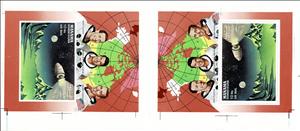Tete-Beche: Apollo 7 over moon landscape (Manama 1968)
Apollo 7 over moon landscape (Manama 1968)
25 November (Manama ) within release Apollo 7 goes into circulation Tete-Beche Apollo 7 over moon landscape face value 10+10 Qatari riyal
| Tete-Beche Apollo 7 over moon landscape in catalogues | |
|---|---|
| Colnect codes: | Col: AJ-MN 1968.11.25-01 |
Tete-Beche is square format.
Also in the issue Apollo 7:
- Stamp - Apollo flight face value 25;
- Stamp - Apollo Landing face value 15;
- Stamp - Yuri Gagarin (1934-1968), Soviet air force officer, and cosm face value 5;
- Stamp - Edward White face value 10;
- Stamp - Vostok face value 15;
- Stamp - Mercury face value 20;
- Souvenir Sheet - Edward White face value 10;
- Stamp - Yuri Gagarin (1934-1968), Soviet air force officer, and cosm face value 5;
- Stamp - Edward White face value 10;
- Stamp - Apollo flight face value 25;
- Stamp - Mercury face value 20;
- Souvenir Sheet - Mercury face value 20;
- Tete-Beche - Apollo 7 over moon landscape face value 10+10;
- Souvenir Sheet - Apollo 7 over moon landscape face value 10;
- Stamp - Apollo Flight face value 25;
- Stamp - Apollo Landing face value 15;
- Stamp - Apollo Landing face value 15;
- Stamp - Apollo Trajectory face value 15;
- Souvenir Sheet - Apollo Trajectory face value 15;
- Stamp - Apollo Trajectory face value 15;
- Souvenir Sheet - Apollo Trajectory face value 15;
- Stamp - Edward White face value 10;
- Stamp - Edward White face value 10;
- Stamp - Lunar Landscape face value 10;
- Souvenir Sheet - Lunar Landscape face value 10;
- Stamp - Lunar Landscape face value 10;
- Souvenir Sheet - Mercury face value 20;
- Souvenir Sheet - Vostok face value 15;
- Stamp - Yuri Gagarin (1934-1968), Soviet Aviation Officer and Cosmo… face value 5;
- Full Pane - Yuri Gagarin (1934-1968), Soviet Aviation Officer and Cosmo… face value 6*5;
- Stamp - Yuri Gagarin (1934-1968), Soviet Aviation Officer and Cosmo… face value 5;
|
Data entry completed
46%
|
|
|---|---|
| Tete-Beche Apollo 7 over moon landscape in digits | |
| Country: | Manama |
| Date: | 1968-11-25 |
| Emission: | Commemorative |
| Format: | Tete-Beche |
| Face Value: | 10+10 Qatari riyal |
Tete-Beche Apollo 7 over moon landscape it reflects the thematic directions:
An astronaut (from the Ancient Greek ἄστρον (astron), meaning 'star', and ναύτης (nautes), meaning 'sailor') is a person trained, equipped, and deployed by a human spaceflight program to serve as a commander or crew member aboard a spacecraft. Although generally reserved for professional space travelers, the term is sometimes applied to anyone who travels into space, including scientists, politicians, journalists, and tourists
A map is a symbolic depiction emphasizing relationships between elements of some space, such as objects, regions, or themes. Many maps are static, fixed to paper or some other durable medium, while others are dynamic or interactive. Although most commonly used to depict geography, maps may represent any space, real or imagined, without regard to context or scale, such as in brain mapping, DNA mapping, or computer network topology mapping. The space being mapped may be two dimensional, such as the surface of the earth, three dimensional, such as the interior of the earth, or even more abstract spaces of any dimension, such as arise in modeling phenomena having many independent variables. Although the earliest maps known are of the heavens, geographic maps of territory have a very long tradition and exist from ancient times. The word "map" comes from the medieval Latin Mappa mundi, wherein mappa meant napkin or cloth and mundi the world. Thus, "map" became the shortened term referring to a two-dimensional representation of the surface of the world.
The Moon is Earth's only natural satellite. It orbits at an average distance of 384,400 km (238,900 mi), about 30 times the diameter of Earth. Tidal forces between Earth and the Moon have over time synchronized the Moon's orbital period (lunar month) with its rotation period (lunar day) at 29.5 Earth days, causing the same side of the Moon to always face Earth. The Moon's gravitational pull – and to a lesser extent, the Sun's – are the main drivers of Earth's tides.
Outer space (or simply space) is the expanse that exists beyond Earth's atmosphere and between celestial bodies. It contains ultra-low levels of particle densities, constituting a near-perfect vacuum of predominantly hydrogen and helium plasma, permeated by electromagnetic radiation, cosmic rays, neutrinos, magnetic fields and dust. The baseline temperature of outer space, as set by the background radiation from the Big Bang, is 2.7 kelvins (−270 °C; −455 °F)





